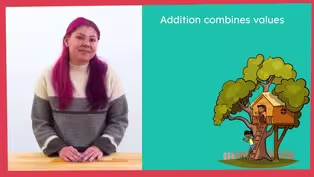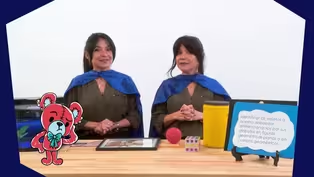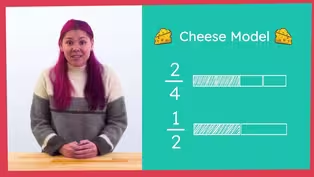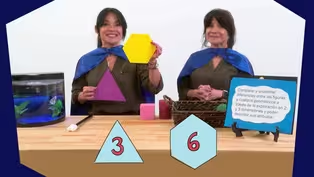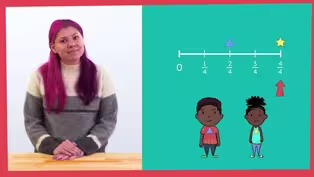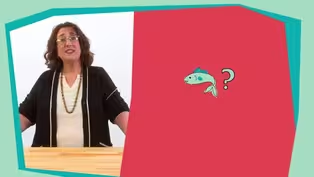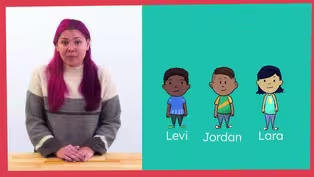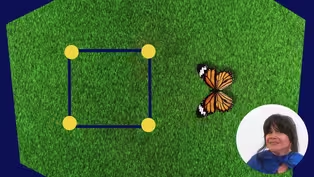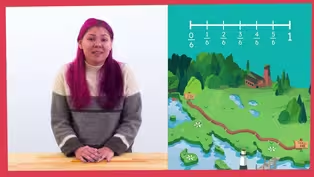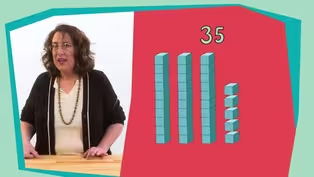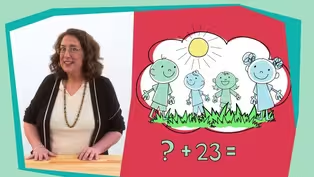
Episode 16 | Math Lessons
3/22/2021 | 28m 46sVideo has Closed Captions
Math lessons for early learners, led by NC teachers.
The first lesson (aimed at 3rd graders) shows students how problems involving multiplication and division can be represented and solved with arrays. The second lesson (aimed at PreK-K learners) helps early learners understand the relationship between numbers and quantities. Classroom Connection is your At-Home Learning companion where children love to learn. All lessons are led by NC educators.
Problems playing video? | Closed Captioning Feedback
Problems playing video? | Closed Captioning Feedback
At-Home Learning Presents: Classroom Connection is a local public television program presented by PBS NC

Episode 16 | Math Lessons
3/22/2021 | 28m 46sVideo has Closed Captions
The first lesson (aimed at 3rd graders) shows students how problems involving multiplication and division can be represented and solved with arrays. The second lesson (aimed at PreK-K learners) helps early learners understand the relationship between numbers and quantities. Classroom Connection is your At-Home Learning companion where children love to learn. All lessons are led by NC educators.
Problems playing video? | Closed Captioning Feedback
How to Watch At-Home Learning Presents: Classroom Connection
At-Home Learning Presents: Classroom Connection is available to stream on pbs.org and the free PBS App, available on iPhone, Apple TV, Android TV, Android smartphones, Amazon Fire TV, Amazon Fire Tablet, Roku, Samsung Smart TV, and Vizio.
Providing Support for PBS.org
Learn Moreabout PBS online sponsorshipMore from This Collection
Math lessons for early learners, led by NC teachers.
Video has Closed Captions
Math lessons for early learners, led by NC teachers. (28m 46s)
Video has Closed Captions
Math lessons for early learners, led by NC teachers. (28m 46s)
Video has Closed Captions
Math lessons for early learners, led by NC teachers. (28m 46s)
Video has Closed Captions
Math lessons for early learners, led by NC teachers. (28m 46s)
Video has Closed Captions
Math lessons for early learners, led by NC teachers. (28m 46s)
Video has Closed Captions
Math lessons for early learners, led by NC teachers. (28m 46s)
Video has Closed Captions
Math lessons for early learners, led by NC teachers. (28m 46s)
Video has Closed Captions
Math lessons for early learners, led by NC teachers. (28m 46s)
Video has Closed Captions
Math lessons for early learners, led by NC teachers. (28m 45s)
Video has Closed Captions
Math lessons for early learners, led by NC teachers. (28m 46s)
Video has Closed Captions
Math lessons for early learners, led by NC teachers. (28m 45s)
Video has Closed Captions
Math lessons for early learners, led by NC teachers. (28m 46s)
Providing Support for PBS.org
Learn Moreabout PBS online sponsorship[cheerful upbeat music] ♪ - What's good, my good people?
I'm Mr. R and I'm gonna be your guide on today's learning journey.
There's going to be some twists and some turns.
But mostly we're gonna have some fun.
- Hello friends, Diane here.
I'm so happy to see you again.
Today, we're going to be talking about using arrays to understand multiplication.
I was at the home improvement store yesterday, looking at tiles to use in my kitchen and it made me think about some of our math problems.
Some of the tiles come in arrangements of equal rows and columns.
In mathematics, this is called an array and it's used as a strategy for multiplication.
Before we continue with our lesson today, let's use a frayer model to help us understand a little bit more about arrays.
To make a frayer model you will need a piece of paper and a pen, a pencil, or a marker.
I'm going to get my supplies.
You go ahead and do the same.
[upbeat music] Now that we have our supplies, let's begin to make a frayer model.
Let's take a piece of paper and fold it in half, hamburger style.
Then we are going to fold it in half again.
Finally, we are going to use this corner where all the sides are folded, we're gonna make a small triangle.
When you unfold the paper, it should look like this.
Does yours look like mine?
Okay, great.
We're going to write array in the center diamond because this is the word we need to understand more about.
Then in the upper left rectangle, we're going to define this term.
So let's write the word definition here.
In the upper right triangle we're going to provide an example of arrays.
So let's wright, example here.
And then in the lower left rectangle.
we'll provide a non-example or what arrays are not.
So write non-example here.
Finally in the lower right rectangle, we'll draw a picture to help us visualize what arrays are.
So let's write the word picture here to remind us of what we're supposed to do.
Now we're going to define the word array together.
So let's write the definition in our upper left rectangle.
An array is an arrangement of items into equal rows and columns.
[upbeat music] We can use arrays to help us represent and solve multiplication and division problems.
As we learn more about arrays in today's lesson, you'll be able to add examples, non-examples and draw a picture to share your growing understanding of equal groups.
Now, let's get back to the home improvement store where I was looking at some tile designs.
Let me show you how one tile design looked.
Could you sketch this on your paper?
And then count how many tiles are in this design?
[upbeat music] How many did you count?
Right.
They're eight.
Now, how did you count them?
Okay.
Some of you counted by fours.
Very nice.
I'm going to write the number four at the top of this note.
How many tiles are in each row?
Then, some of you counted by twos.
Two, four, six, eight.
I'm going to write the number two to the left to show how many rows there are.
Remember this arrangement of equal rows and columns is called an array.
We can represent this array with a multiplication equation.
Two times four equals eight.
I like this design, but what if I decided that I wanted to turn it around?
You do this on your paper.
Question now is did the number of tiles change?
No.
How do you know?
Oh, very nice.
The array is still arranged in the same number of groups.
We didn't add any tiles, we also didn't take any tiles away.
This time, there are four rows and we have two in each row.
We can represent this as four times two equals eight.
Did changing the arrangement of the tiles change the total?
No it sure didn't.
So does the order of the factors in our multiplication equation change the answer or the product?
Remember the factors are the number of groups and numbers in each group.
And the product is the total.
Mmh.
I hear some of us are not sure yet.
Let's try another one and see what we find out.
Now take a look at this arrangement.
If you would, draw it on your paper and count how many tiles there are in all.
[upbeat music] Would you whisper what you got to me?
Right.
There's 15.
This time, how did you count these tiles?
Some of you counted by fives.
Five, 10, 15.
So we'll write five at the top to show how many are in each row.
Then some of you counted by threes.
Three, six, nine, 12, 15.
All right.
Three to the left to show how many rows.
So now what's the multiplication equation for this array?
Right?
Three times five.
If I change the order of the factors, three and five, would the total number of tiles or the product change?
Let's see how that would look.
You go ahead and turn your paper.
Now the question is, did we take any tiles away or did we add any tiles?
No.
So how many tiles are there altogether?
Exactly.
15.
The arrangement of the tiles doesn't change the total and the order of the factors doesn't change the product.
Let's try this one.
There are four rows and six in each row.
You draw it and count the number of tiles.
[upbeat music] How many times did you get?
24?
Very nice.
So if you know that a four by six array has 24 tiles, how many tiles would be in a six by four array?
That's right, exactly.
24.
So what if we didn't show the array?
What if I said seven times five?
The sevens are hard for me to memorize, but I know that switching the order of the factors will give me the same answer.
And I know my fives.
So five times seven equals five, 10, 15, 20, 25, 30, 35.
So seven times five equals 35.
That makes learning my facts so much easier.
Since I know that I can switch the order of the factors and the answer will be the same.
So let's do some practice.
Five times four equals, exactly 20.
So four times five equals 20.
What about two times nine?
Exactly, that equals 18.
So nine times two equals 18.
Four times three, say it with me, 12.
So three times four, also 12.
Awesome job mathematicians.
Thanks for helping me think more about how multiplication and arrays are related.
The number of rows and columns are represented by the factors in a multiplication equation.
I learned that changing the arrangement of the tiles, doesn't change the total number of tiles.
So changing the order of the factors in a multiplication equation, doesn't change the total or product.
Great job.
I think this will really help me learn my multiplication facts.
I can't wait to do more math with you.
Until next time, bye y'all.
- One thing I love about North Carolina, is how diverse our state is.
There are people here from all cultures.
There's some look like you.
And some don't.
The important thing is to remember is to be kind to everyone, respect your neighbors and not to judge people for what they look like or where they're from.
Who knows, they may end up being your best friend.
- Hey.
My name is Dustin [indistinct] and this is my dad [indistinct] We live in Chapel Hill, North Carolina but my dad is originally, where are you originally from dad?
- From American Samoa.
- American Samoa.
And we wanna do a song right now that teaches you a little bit of the Samoan language from chapel Hill Allianz when you're ready dad.
- I would've been here 50 years so.
[both laughing] Okay.
- Here we go.
[guitar strings playing] [singing Samoan song "Savalivali Means Go for a Walk"] - All right, here we go dad.
[singing Samoan language song] [singing Samoan language song] Whoa!
- The longest French fries ever recorded was 34 inches long.
Y'all.
That's probably bigger than some of you at home right now.
Math helps us measure height, distance, and so much more.
So let's get into that math lesson right now.
- Hello, super learners.
Miss M here.
I am so glad that you are here today.
Are you ready for another math adventure today?
Well, let's get started.
♪ Hello super learners how are you ♪ ♪ Hello super learners how are you ♪ ♪ I'm so glad you're here today ♪ ♪ and I hope you feel the same ♪ ♪ Hello super learners how are you ♪ How are you today super learners?
I feel startastic today and I hope you do too.
Let's get started with our math power warm ups, counting up to 20.
Are you ready?
Here we go.
♪ One two three four five six seven ♪ ♪ eight nine 10 11 12 ♪ ♪ 13 14 15 16 17 18 19 20 ♪ ♪ That was fun ♪ Well, now it's time to snap count up to 20.
Ready?
Let's go.
One, two, three, [finger snapping] four, five, six, [fingers snapping] seven, eight, nine, [fingers snapping] 10.
Let's keep going.
11, 12, 13, [fingers snapping] 14, 15, 16, [fingers snapping] 17, 18, 19 [fingers snapping] 20, yes.
♪ Super nervous are the best.
♪ I'm feeling all warmed up and I hope you are too.
One more time counting.
But this time in Spanish Uno, dos, tres, cuatro, cinco seis, siete, ocho, nueve, diez, once, dose, trece, catorce, quince, dieciseis, diecisiete, dieciocho, diecinueve, veinte, veinte, Amazing, amazing super learners.
Now let's time to review our colors in English and Spanish.
Rojo, red.
Naranjo, orange.
Amarillo, yellow.
Verdy, green.
Azul, blue.
Morado, purple.
Cafe, brown.
Negro, black.
Blanco, white.
And Gris, gray.
Look for these colors in the world today.
And now for our last math power warmup.
Time for the shape game, you'll see a shape.
And then you say its name, in English or Spanish.
Cuadrado, square.
Circulo, circle.
Triangulo, triangle.
Rectangulo, rectangle.
Rombo, rhombus Trapecio, trapezoid, Hexagono, hexagon, Cubo, cube, Cono, cone Cilindro, cylinder.
Esfera, sphere.
Mathtastic.
I hope you are all warmed up because it's time for our math mission of the day.
Come on.
Let's check in with Sparkles, the fish to see what our mission is today.
Hello, Sparkles.
Thank you Sparkles.
Here it is.
Dear super learners.
Your mission today is to count to know the total number of objects.
There are two different mini missions today where there are certain number of objects needed.
Count to find the right group of objects for each mini mission.
Well, super learners, a total is an amount or number of something.
For example, I have one, two, three, four, five.
Five fingers on my hand.
Each finger is only one but all together I have five in total.
So today we will count different groups of objects to find the ones that have the totals that we need.
Super learners, I know we can do this mission.
[upbeat music] Caps on.
Math power up.
Let's go.
Hey, here are two different cups of hot chocolate.
Yum, with many marshmallows.
And look here is our first mini mission.
A friend loves to put seven mini marshmallows in their hot chocolate.
Which cup of hot chocolate should they drink?
Cup A or cup B?
What do you think?
All right, super learners.
Let's count the two groups to see which cup has the marshmallows we need.
When we count the marshmallows, we can only count each one once in order to know the right total.
Ready?
Let's count.
Math power up.
Let's count cup A.
One, two, three, four, five, six, seven, eight, nine, 10.
This cup has 10 marshmallows.
You see the number 10 above the cup?
That's so we can remember the total.
Well now let's count the other cup.
One, two, three, four, five, six, seven.
This cup has seven marshmallows in total.
So which cup should the friend drink?
Yes, super learners.
Cup B.
There are seven marshmallows in cup B. Amazing job, super learners.
We completed our first mini mission.
One more to go.
We can do it super learners.
But before we do, let's play a math moves game.
I will pull out two cards.
You'll see them on the screen each round.
One will tell us a move and the other will be a number card, which will tell us how many to do.
Ready to play?
Math power up.
Ooh.
Nine leg lifts.
One, two, three, four, five, six, seven, eight, nine.
Eight raise the roofs.
One, two, three, four, five, six, seven, eight.
10 skips in place.
One, two, three, four, five, six, seven, eight, nine, 10.
Two big knee bends.
One, two.
Four jumps.
One, two, three, four.
Great job, super learners.
I think we are ready for our next mini mission.
Wow.
Look at these two shirts.
I wonder what our mini math mission is.
Oh, look.
Here it is.
It says a friend wants to wear a shirt with nine hearts on it.
Which shirt should they choose?
Shirt A or shirt B?
What do you think?
Well, super learners, we know what to do.
Let's count.
Math power up.
Let's count the hearts on shirt A first.
One, two, three, four, five, six, seven, eight, nine.
There are nine hearts on shirt A.
You will see a nine above the shirt so that we remember the total.
Ready?
Let's count the hearts on shirt B.
One, two, three, four, five, six.
There are six hearts on this shirt.
You'll see that number six so that we can remember the total.
Okay, super learners.
We have counted the hearts on both shirts.
Which shirt should the friend choose?
I'm listening.
Yes.
Shirt A has nine hearts.
We did it super learners.
We count the hearts and found the right shirt.
Hey, in fact, we counted and found the right cup of hot chocolate too.
Let's check back with sparkles, the fish.
Mission complete.
Thank you sparkles.
Congratulations, super learners.
You used your math power and completed the mission.
What is it time to do?
Let's review.
We can count objects by counting each one, one at a time.
Remember to count each object only once in order to get the right total or amount.
Touching or marking each object as we count, helps us to count accurately for the correct amount.
Practice counting today super learners.
You can share your math power by showing it to someone.
Thank you, super learners for going on a math mission with me today.
Sparkles, thanks you too.
Remember you have the power to be super at math.
Bye, audio math power out.
[upbeat music] - Can't talk now.
About to show this video to the classroom.
Hey, y'all check this out.
[upbeat music] ♪ Kids everybody upstairs to brush teeth ♪ ♪ Kids everybody upstairs to brush teeth ♪ ♪ Kids everybody upstairs to brush teeth ♪ ♪ Kids every kid every kid ♪ ♪ Kids kids kids kids kids kids kids kids ♪ ♪ Kids kids kids kids kids kids kids kids ♪ ♪ Brush right to left right to left right to left ♪ ♪ Right to left right to left right to left ♪ ♪ Right to left right to left right to left ♪ ♪ Rinse the mouth and spit it out ♪ ♪ Rinse that mouth and spit it out ♪ ♪ Rinse that mouth and spit it out ♪ ♪ Rinse that mouth and spit it out ♪ ♪ Right to left right to left right to left ♪ ♪ Right to left right to left right to left ♪ ♪ Juggle it round no side ♪ ♪ Right to left right to left ♪ ♪ Look at my glowing white ♪ ♪ Right to left right to left right to left ♪ ♪ Look at my sparkling tooth brush ♪ ♪ Get it to clean and white ♪ ♪ Get it to clean at night ♪ ♪ Get to clean in the morning ♪ ♪ And it will feel all right ♪ ♪ No plaque no way ♪ ♪ I've got a glowing whites on my face ♪ ♪ No plaque no way ♪ ♪ Don't forget to brush ♪ ♪ Brush brush brush ♪ ♪ Brush ♪ ♪ You've go to brush your teeth ♪ ♪ Brush ♪ ♪ Tooth brush tooth brush tooth brush tooth brush ♪ Well, that was great.
We got the brain juices flowing and we're ready for anything.
I'm grateful for math because it challenges me to use a lot of my brain.
And I'm also grateful to be learning with you.
[cheerful upbeat music] ♪


- Home and How To

Hit the road in a classic car for a tour through Great Britain with two antiques experts.












Support for PBS provided by:
At-Home Learning Presents: Classroom Connection is a local public television program presented by PBS NC
